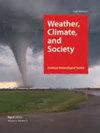调查尼泊尔博卡拉市空气污染、气象和慢性阻塞性肺病趋势之间的关系
IF 1.9
4区 地球科学
Q3 ENVIRONMENTAL STUDIES
引用次数: 0
摘要
博卡拉大都会占地464.24平方公里,是尼泊尔面积最大的城市。这里有40多万居民,也是尼泊尔人口第二大城市。本研究调查了博卡拉大都会城市内存在的与空气污染、气象和健康有关的生物气象系统。该系统的不同方面在城市的各个地区或多或少都有影响,了解这些关系可以帮助未来的健康干预措施,以限制接触污染物。这项研究是使用政府记录和科学文献中发表的数据集完成的,展示了开源数据可以实现的目标。关键发现是空气污染水平与博卡拉西部地区医院的慢性阻塞性肺病住院人数呈正相关,气象测量与住院人数呈负相关。这些发现与关于慢性阻塞性肺病和住院风险因素的一般文献一致。多变量回归使用平均低温和高温对住院进行了更好的预测,而不是使用一个温度变量,这意味着每天的低温和高温都与住院相关。结果还显示,与2.5微米及以下的空气污染物相比,小于或等于10微米和大于2.5微米的污染物的空气污染水平更能预测住院人数。这些发现引发了人们对不同污染物大小之间的关系及其与慢性阻塞性肺病住院的相关性的质疑。研究结果还产生了有关健康干预和博卡拉建筑环境的问题,这些问题可能会在未来的研究中进行调查。本文章由计算机程序翻译,如有差异,请以英文原文为准。
Investigating the relationship between air pollution, meteorology, and COPD trends in Pokhara Metropolitan City, Nepal
Spanning 464.24 km2, Pokhara Metropolitan City is Nepal’s largest city by area. With over 400,000 residents, it’s also Nepal’s second most populous city. This research investigated a biometeorological system present within Pokhara Metropolitan city concerning air pollution, meteorology, and health. Different aspects of this system are more or less influential in various regions of the city and understanding these relationships can assist with future health interventions for limiting exposure to pollutants. This research was completed using data sets published in government records and scientific literature, showcasing what can be accomplished with open-source data. Key findings were a positive correlation between air pollution levels and chronic obstructive pulmonary disease hospital admissions into Pokhara’s Western Regional Hospital and a negative correlation between meteorological measurements and hospital admissions. These findings aligned with the general body of literature regarding risk factors for chronic obstructive pulmonary disease and hospitalizations. Multivariate regressions yielded better predictions for hospital admissions using both mean low and high temperatures as opposed to using one temperature variable, which implied both daily low and high temperatures correlate to hospital admissions. Results also revealed air pollution levels for pollutants equal to or less than ten micrometers and greater than 2.5 micrometers were better predictors of hospital admissions than air pollutants sized 2.5 micrometers and below. Findings prompted questions about the relationships between different pollutant sizes and their correlations to chronic obstructive pulmonary disease hospitalizations. Findings also yielded questions regarding health interventions and Pokhara’s built environment, which may be investigated in future research.
求助全文
通过发布文献求助,成功后即可免费获取论文全文。
去求助
来源期刊

Weather Climate and Society
METEOROLOGY & ATMOSPHERIC SCIENCES-
CiteScore
3.40
自引率
13.60%
发文量
95
审稿时长
>12 weeks
期刊介绍:
Weather, Climate, and Society (WCAS) publishes research that encompasses economics, policy analysis, political science, history, and institutional, social, and behavioral scholarship relating to weather and climate, including climate change. Contributions must include original social science research, evidence-based analysis, and relevance to the interactions of weather and climate with society.
 求助内容:
求助内容: 应助结果提醒方式:
应助结果提醒方式:


